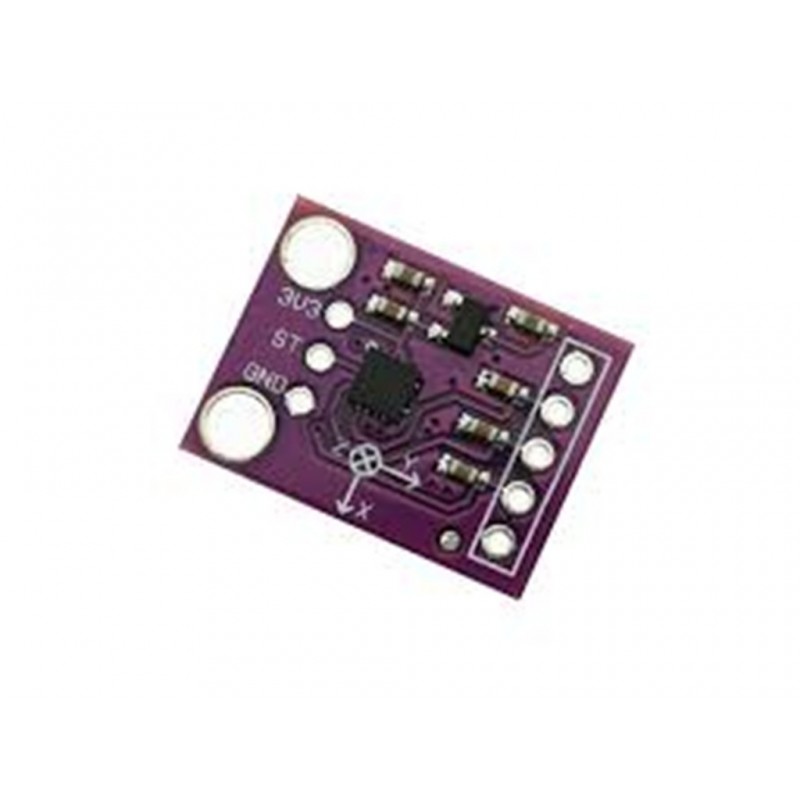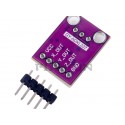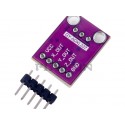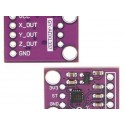Adxl337 Module 3 Axis Analog Output Accelerometer
Rs. 341.00 Rs. 382.00
- Brand: https://www.analog.com/en/products/adxl337.html#product-overview
- Product Code: SEN-ACCELEROMETER
- Availability: 2-3 Days
- Price in reward points: 4
- For Bulk Order
 9962060070
9962060070
SPECIFICATIONS
TA = 25°C, VS = 3 V, CX = CY = CZ = 0.1 μF, acceleration = 0 g, unless otherwise noted. All minimum and maximum specifications are
guaranteed. Typical specifications are not guaranteed.
Table 1.
Parameter Test Conditions/Comments Min Typ Max Unit
SENSOR INPUT Each axis
Measurement Range ±3 ±3.6 g
Nonlinearity % of full scale ±0.3 %
Package Alignment Error ±1 Degrees
Interaxis Alignment Error ±0.1 Degrees
Cross-Axis Sensitivity1
±1 %
SENSITIVITY (RATIOMETRIC)2
Each axis
Sensitivity at XOUT, YOUT, ZOUT VS = 3 V 270 300 330 mV/g
Sensitivity Change Due to Temperature3 VS = 3 V ±0.01 %/°C
0 g BIAS LEVEL (RATIOMETRIC)
0 g Voltage at XOUT, YOUT VS = 3 V 1.35 1.5 1.65 V
0 g Voltage at ZOUT VS = 3 V 1.2 1.5 1.8 V
0 g Offset vs. Temperature XOUT, YOUT ±1.1 mg/°C
0 g Offset vs. Temperature ZOUT ±1.6 mg/°C
NOISE PERFORMANCE
Noise Density XOUT, YOUT 175 μg/√Hz rms
Noise Density ZOUT 300 μg/√Hz rms
FREQUENCY RESPONSE4
Bandwidth XOUT, YOUT5 No external filter 1600 Hz
Bandwidth ZOUT5 No external filter 550 Hz
RFILT Tolerance 32 ± 15% kΩ
Sensor Resonant Frequency 5.5 kHz
SELF TEST6
Logic Input Low 0.6 V
Logic Input High 2.4 V
ST Actuation Current 60 μA
Output Change at XOUT Self test 0 to 1 −150 −325 −600 mV
Output Change at YOUT Self test 0 to 1 +150 +325 +600 mV
Output Change at ZOUT Self test 0 to 1 +150 +550 +1000 mV
OUTPUT AMPLIFIER
Output Swing Low No load 0.1 V
Output Swing High No load 2.8 V
POWER SUPPLY
Operating Voltage Range7 1.8 3.0 3.6 V
Supply Current VS = 3 V 300 μA
Turn-On Time8 No external filter 1 ms
TEMPERATURE
Operating Temperature Range −40 +85 °C
OVERVIEW:
-3-axis sensing
-Small, low profile package
-3 mm × 3 mm × 1.45 mm LFCSP
-Low power: 300 μA (typical)
-Single-supply operation: 1.8 V to 3.6 V
-10,000 g shock survival
-Excellent temperature stability
-Bandwidth adjustment with a single capacitor per axis
-RoHS/WEEE and lead-free compliant
PACKAGE INCLUDES:
1 PCS x Adxl337 Module 3 Axis Accelerometer Analog Output
https://www.analog.com/en/products/adxl337.html#product-overview
//SOURCE CODE TAKEN FROM BELOW LINK
//http://arduinolearning.com/code/adxl337-accelerometer-arduino-uno-example.php
void setup()
{
// Initialize serial communication at 115200 baud
Serial.begin(115200);
}
// Read, scale, and print accelerometer data
void loop()
{
// Get raw accelerometer data for each axis
int rawX = analogRead(A0);
int rawY = analogRead(A1);
int rawZ = analogRead(A2);
// Scale accelerometer ADC readings into common units
// Scale map depends on if using a 5V or 3.3V microcontroller
float scaledX, scaledY, scaledZ; // Scaled values for each axis
scaledX = mapf(rawX, 0, 675, -scale, scale); // 3.3/5 * 1023 =~ 675
scaledY = mapf(rawY, 0, 675, -scale, scale);
scaledZ = mapf(rawZ, 0, 675, -scale, scale);
// Print out raw X,Y,Z accelerometer readings
Serial.print("X: "); Serial.println(rawX);
Serial.print("Y: "); Serial.println(rawY);
Serial.print("Z: "); Serial.println(rawZ);
Serial.println();
// Print out scaled X,Y,Z accelerometer readings
Serial.print("X: "); Serial.print(scaledX); Serial.println(" g");
Serial.print("Y: "); Serial.print(scaledY); Serial.println(" g");
Serial.print("Z: "); Serial.print(scaledZ); Serial.println(" g");
Serial.println();
delay(2000); // Minimum delay of 2 milliseconds between sensor reads (500 Hz)
}
// Same functionality as Arduino's standard map function, except using floats
float mapf(float x, float in_min, float in_max, float out_min, float out_max)
{
return (x - in_min) * (out_max - out_min) / (in_max - in_min) + out_min;
}
// Make sure these two variables are correct for your setup
int scale = 3; // 3 (±3g) for ADXL337, 200 (±200g) for ADXL377
//connection
//x-a0,y-a1,z-a2
//output
//Open the serial monitor and you will see something like this
//X: 384
//Y: 340
//Z: 281
//X: 0.41 g
//Y: 0.02 g
//Z: -0.50 g
//X: 410
//Y: 345
//Z: 345
//X: 0.64 g
//Y: 0.07 g
//Z: 0.07 g
15 days




